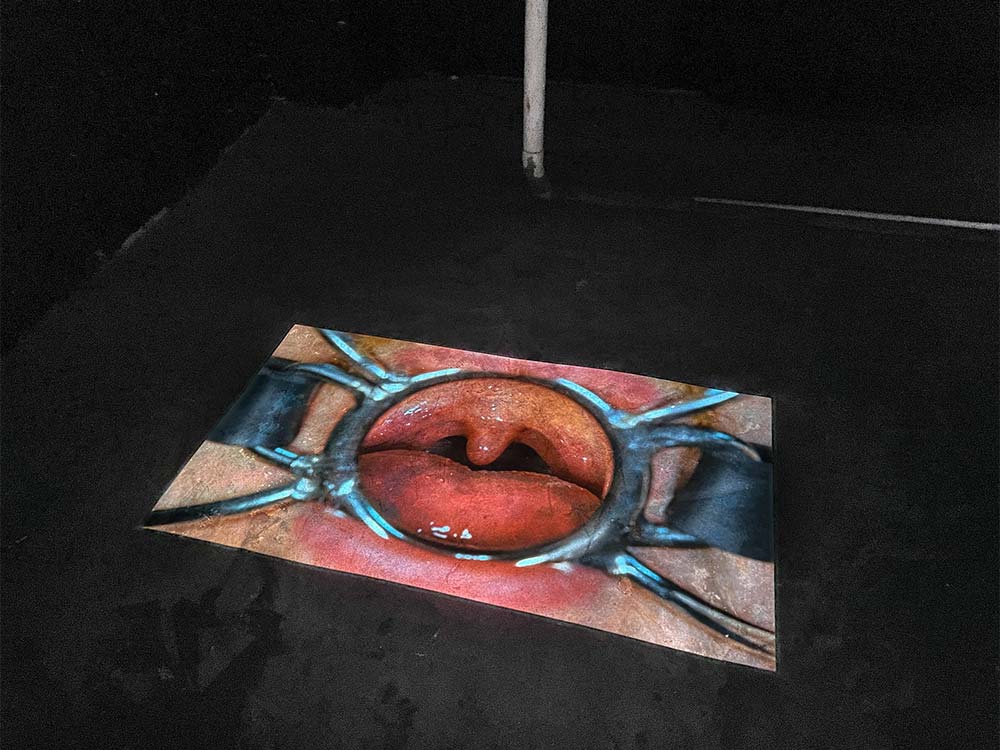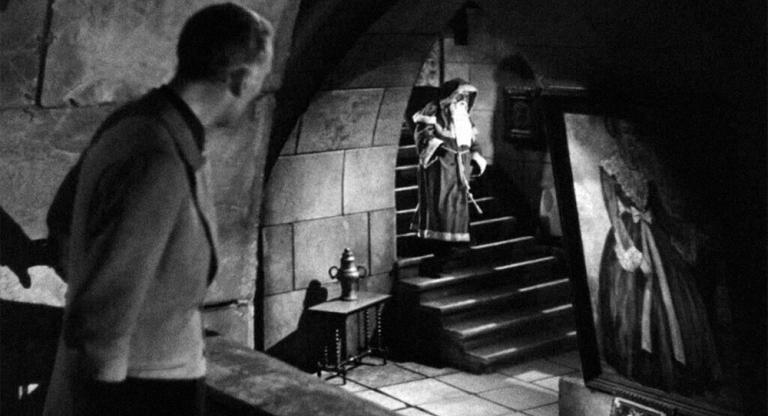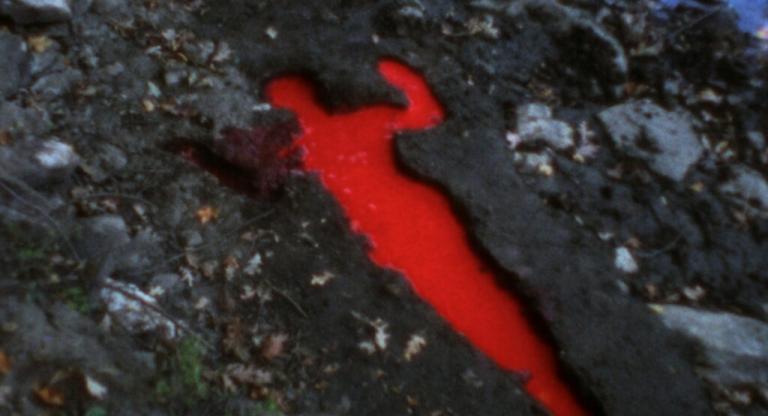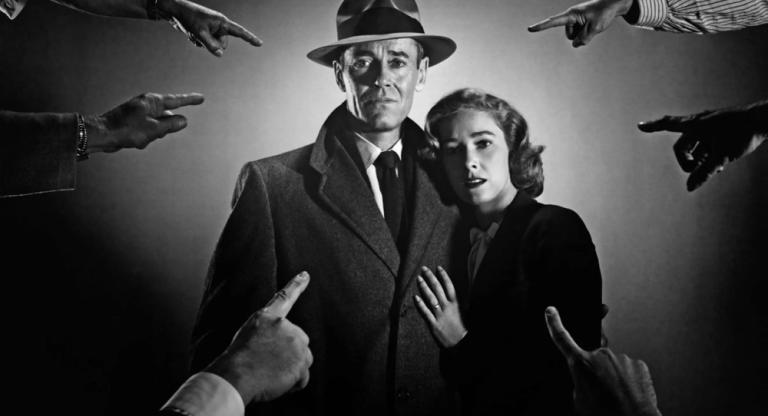In Peter Clough’s video ON THE EROTICS OF STUFFING LARGE OBJECTS INTO SMALL SPACES (2022) the artist is crammed into a Amazon-bought dog cage while his voice describes the dark, dirty space in which he is inserted. Clough wears a kinky mask, has a butt plug inserted, and has on cock cage while his overlaid voice describes his pleasure in all this.
This video was shown within the exhibition Exaltation of the Porous Body, at Haul Gallery in Brooklyn, which closed down shortly after its opening due to interference by the gallery’s landlord in early May 2022. (Haul has since relocated to a construction trailer in Gowanus.) The closure was reportedly prompted by the content of the show. So someone shoving something up their ass on a video can still lead to uninspired, hysterical reactions, but it could also lead to art’s political becoming. The censure of Clough’s work should make us think about the queer cultural production happening today, especially that which is not funded or circulated by large, tokenizing institutions and platforms. The anti-queer sentiment of previous decades continues today, though it circulates differently. The incident recalls similarly contentious art happenings: the US Navy’s 1934 concealment of Peter Cadmus’s painting The Fleet’s In!; the 1989 cancellation of Robert Mapplethorpe’s The Perfect Moment exhibition at the Corcoran Gallery in Washington, D.C.; a landlord’s 2018 removal of Alisha B. Wormsely’s art billboard in Pittsburgh.
The soft power of funding models has gone to work on queer, sexual, and other explicit identity artwork, allowing only the most generally palatable representations to surface for public consumption. Clough’s practice engages concepts that aren’t often addressed in popular LGBTQIA+ culture. If these topics are acknowledged they are infantilized, parodied, generalized, or completely declawed and dehistoricized. Clough uses his own body as material to address issues of his lived experiences of gender dysphoria, kinship and consent, and kink and BDSM values. This results in edited images of his body mixed into sculptural installations. Pictures of his butthole might be attached to architecturally built models that lay on the floor or hang on the wall; there might be screens inserted into the artwork or video might be projected onto it. Clough is generous: you can laugh at the work in addition to pondering it. He might be “sucking cock and getting his pussy bred" and at the same time be reciting an earnest queer love story. The work is sometimes hard to watch. The tension this difficulty creates, compared to mainstream queer visual media, confronts institutional engagements with ‘queerness and as well as viewers seeking certain types of art with uncomfortable distinctions of “why we like this queer art, but not that queer art.”
I posed a few questions to Clough following the cancellation of his show.
Tannon Reckling: What are some significant historical LGBTQ+ happenings that have affected practice over time?
Peter Clough: In the mid-’90s, before gay marriage and PrEP changed the conversation in the US, the main political message of pro-gay groups was to come out of the closet. Coming out was seen as enormously brave, radical, and risky (which it still is for most people). But I think “coming out” is kind of misunderstood. We often think of it like a declaration, like planting a flag to claim one identity or another forever, but I’d rather think of coming out as a sort of story-telling. It’s a moment when we speak for ourselves about our desires, about the sexual functioning of our body, and make the claim that our behaviors and desires are valid, healthy, and normal. In the kink community, you often hear people describe coming out twice, once when they’re younger and come out as gay (or queer, bi, trans, whatever), and another later on when they come out as kinky in some way. There’s often the sense that coming out of the closet and claiming our “identity” isn’t the full story, and there’s a lot more we have to say in order to feel like our sexuality is recognized and understood.
TR: What are some queer sensibilities that have formed your perspective?
PC: This is always a strangely hard question. I think we’re desperate to try to construct and claim a queer history, in part because the AIDS epidemic took so many of our queer forebearers away from us, and in part because the invisibility of being in the closet makes tracing these histories so challenging. Most of us were taught a version of our history from our families, but for most of us, there weren’t any queer people in it. And of course there are still people actively working to remove queer histories from libraries and schools across the country. So I think that this desire to build a history out of scraps is really endemic to the queer experience. We have a longing to belong, not only to each other or to a community but to belong to a lineage that feels like our own, even if it’s a broken one.
I’m from a small town in rural Minnesota, but I was lucky to have a group of leftist, activist friends in high school. They helped coax me from the closet when I was 15 and together we formed our school’s first “gay-straight alliance.” (Remember when the word “queer” used to be an insult?) But it wasn’t like I had a sense of a queer history at that point. I had never heard of ACT UP or Gran Fury or Wojnarowicz, or even Stonewall. I just knew that I was tired of being bullied in school, and that the sexual functioning of my body and the desires inscribed into it were nothing like the hetero-reproductive fairy tale I had been force-fed my whole life.
The films and performances I’m making now can be understood in this context as a sort of extended “coming out” that’s focused on that idea of story-telling. I’m not really interested in the idea of identity. Mine keeps changing and shifting anyway, and I hate the idea of these things being fixed in place. But I love the idea of sharing stories, in their strange messiness. Story-telling is activism.
TR: How has your practice changed in terms of your engagement with screen-based interactions and circulation of images?
PC: When I came out of the closet, the internet was really young. Yahoo groups existed, and there was email, but nothing we’d consider a social network like we have today. The internet was mostly individual websites, and I really had to dig to find the few tech-savvy kinksters who bothered building their own site to post pictures of their kink lives. It was very isolating, and I remember worrying that I might never meet another person who shared my sexual fantasies. But social media can give us a place to share our lives with the relative comfort of anonymity, and to help us find like-minded people. Grindr, Scruff, Recon, and now Twitter have definitely helped me feel more comfortable with myself and to understand how common it is to be locked in chastity or to wear diapers or want to be tied up or encased in latex or whatever. Those things all feel super normal to me now.
The flip side of this, though, is censorship. Instagram, Facebook, TikTok, and of course now Tumblr not only ban sexual images but disproportionately target LGBTQIA+ creators, removing people’s entire accounts for totally arbitrary “violations.” I remember using an image of me in a lacy thong to promote an exhibition, and Instagram said it was “sexual solicitation,” the term they use to classify and target sex workers. Even Vimeo, which allows nudity, removed my work for being “pornographic.” So it’s important to remember that these “platforms'' aren't neutral, and their only purpose is to keep us addicted, extract our data, and sell our attention to advertisers. But I take this whole constellation of relations as source material for my work, and I’m not really interested in nostalgia for the days of cruising in bathrooms or parks. Maybe if my hometown had a better park.
After the early closure of his exhibition at Haul Gallery, Clough showed the same video work at Anthology Film Archives last month as part of the series “Narrow Rooms” curated by Adam Baran. The series will continue in November.
Image: Peter Clough, Drain, Digital Video, 7 Minutes, 2022



